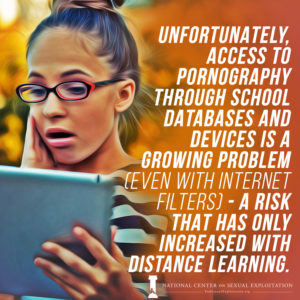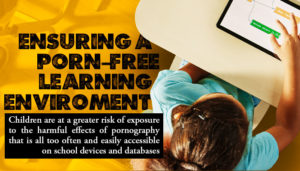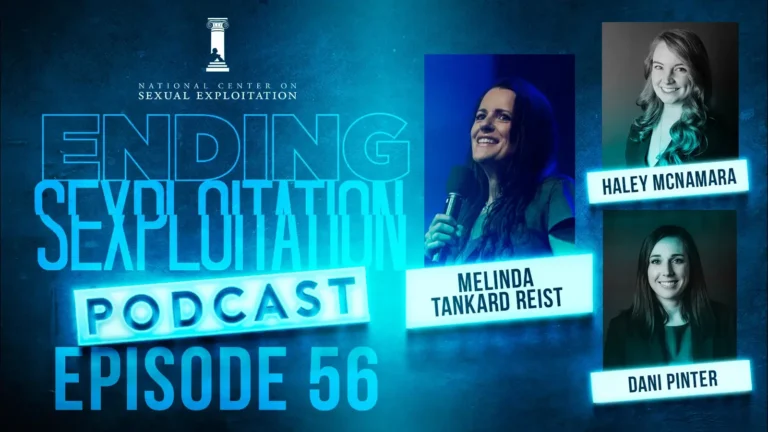Our children’s health and well-being affects not only them as individuals, but greatly determines the overall health and well-being of our families, our communities, our country. Among the greatest threats our youth are currently facing is exposure to harmful pornography and sexually graphic material which can greatly affect their short and long-term mental, physical, and socio-emotional health. Unfortunately, access to pornography through school databases and devices is a growing problem (even with Internet filters)—a risk that has only increased with distance learning. Protecting our children from online harms—including at school—must be a cross-sectoral, multi-entity, bipartisan priority. Overburdened schools and overwhelmed parents do not have the capacity to address this growing problem on their own and need support from those entities that have the authority and reach to make broad policy changes across states and schools, and that includes the US federal government.

Unfortunately, access to pornography through school databases and devices is a growing problem (even with #InternetFilters)—a risk that has only increased with #DistanceLearning. Share on X
The US education system is federalized, meaning individual states hold the primary responsibility for setting education policy and laws, selecting and establishing curriculum, as well as for providing funding for K–12 public schools (established through the 10th Amendment). However, the US federal government—specifically the US Department of Education—does of course still play a significant role in the education system. The Dept. of Education’s mission is to “promote student achievement and preparation for global competitiveness by fostering educational excellence and ensuring equal access.” The Department focuses national attention on major issues impacting education, collects data and disseminates research, sets national standards and creates best practices, establishes policies and monitors federal funding, and protecting students against discrimination.
So what can DOE do to promote kids’ online safety at school? More than it’s doing now.

In accordance with the Dept. of Education’s mandate to identify the major issues and problems in education and focus national attention on them, the Department could take significant measures to highlight the growing problem of exposure to pornography and harmful sexually explicit material through school-issued devices and research databases. Through data collection and research, it could provide schools with much-needed resources and information about how to best keep students safe online. The Department could bring together other relevant federal agencies and experts to determine and disseminate best practices and provide training to ensure online safety (as it did for anti-bullying). And it could use its authority to put pressure on corporations that are greatly profiting from and significantly determining our children’s learning content to adhere to federal and state laws concerning children’s access to porngraphy and other harmful materials.
.@USedgov should provide schools with resources and information about how to #ProtectChildrenOnline. Share on X
Specifically, the Department of Education could play a lead role in:
- Pressing major technology manufacturers to automatically turn on the built-in filters and safety controls on all devices distributed to students, especially the widely-used and problematic Google Chromebooks. Even if schools are filtering Internet and Wi-fi, additional safety measures must be taken on the devices themselves and on any websites or platforms (such as Youtube) used by schools. Schools don’t always have the capacity or know-how to do so— especially during distance learning.
- Establishing guidelines for research database companies used by schools, such as EBSCO or Gale, requiring removal of sexually explicit and pornographic material from all K–12 databases. These databases claim they are age-appropriate and contain only curriculum-related content. However, throughout the US, children using these popular databases are subject to harmful material, such as graphic, non-academic sexual images and texts, ads for sex toys and “adult” literature, articles promoting prostitution, and links to porn sites—even hardcore pornography (which is prohibited by federal law and not protected under the First Amendment). These databases bypass Internet filters and aren’t subject to the Children’s Internet Protection Act as they did not exist when this legislation was drafted.
- Encouraging Congress to overhaul the outdated 2001 Children’s Internet Protection Act to take into account the technological advances of the past two decades. CIPA was enacted by Congress to stem children’s access to harmful content over the Internet (including pornography). In order for public schools to receive federal funding for Internet access through the E-rate program (discounts from 20 to 90%), they must prove they are CIPA-compliant. That includes blocking or filtering Internet to prevent access to material that is (a) obscene; (b) child pornography; or (c) harmful to minors. CIPA should be amended to ensure schools and libraries prove CIPA compliance at regular intervals (as technology changes so rapidly) and must close the loophole that allows research databases used by students to bypass CIPA requirements.
- Convening an Interagency Working Group to develop best practices to prevent sexual exploitation and abuse in schools (including exposure to pornography) that would include Department of Education, Department of Justice Child Exploitation and Obscenity Section (CEOS), Health and Human Services, the Federal Communication Commission (including the Office of Educational Technology that oversees CIPA), and other relevant agency personnel. Children’s online safety is an issue that should span any agency entrusted to protecting kids.
- Adding easily-accessible, vetted resources for online safety on Dept. of Education’s schoolsafety.gov webpage, including information, guidelines and resources for school administrators (e.g. ensuring CIPA-compliance when going virtual, risk factors to consider when using social media to communicate with students, and digital safety curricula samples) and parents (e.g. risk assessments of popular apps and games, talking points to discuss online safety with kids, safety control and filtering tool recommendations)
As the numbers of children receiving their education virtually and through school-provided devices continues to increase, it is critical that their environment is safe and conducive to learning. Join us in urging the Department of Education to take concrete steps to keep our students safe: especially in a time when so much is already threatening their health and well-being.
.@USedgov: Please take measures to stop exposure of children to pornography and harmful sexually explicit material through school-issued devices and research databases. Share on X
ACTION 1 : Identify your state’s education governing bodies here and urge them to prioritize creating pornography-free learning environments in schools: specifically ensuring research databases like EBSCO and Gale remove all sexually explicit and pornographic material, including links to porn sites.
ACTION 2: Learn more about federal and state laws relating to filtering, blocking and usage policies in schools and libraries (National Conference of State Legislatures)
*The National Center on Sexual Exploitation’s 2020 Back to School(ing) Campaign aims to equip families and educators with information, resources, and actions they can take to keep kids safe online as vast numbers of students start the school year in a virtual learning environment. Over the four week campaign, we’ll feature the people, organizations, and entities that can have the greatest impact ensuring a safe online learning environment, specifically: families, schools, corporations, and the US federal government. This is Part 4 of 4: the US federal government*



